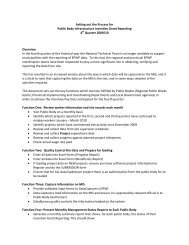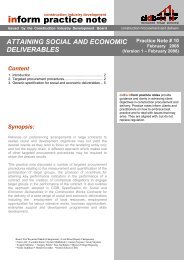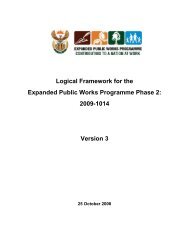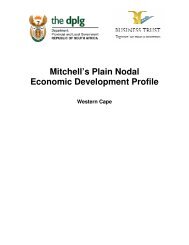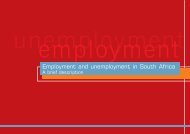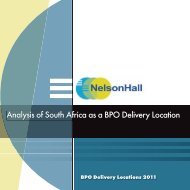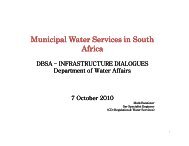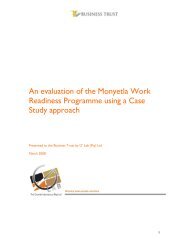National Infrastructure Maintenance Strategy - Construction Industry ...
National Infrastructure Maintenance Strategy - Construction Industry ...
National Infrastructure Maintenance Strategy - Construction Industry ...
You also want an ePaper? Increase the reach of your titles
YUMPU automatically turns print PDFs into web optimized ePapers that Google loves.
can only be done, or can best be done, by labourintensive<br />
methods, and it is thus important that<br />
government's plans for employment creation and<br />
the Expanded Public Works Programme give<br />
prominence to maintenance. Finally, there is<br />
substantial scope for maintenance contracts to<br />
promote SMME development, Broad-Based Black<br />
Economic Empowerment (BBBEE), involvement of<br />
women and youth, and local employment coupled<br />
with appropriate enterprise development.<br />
Based on a conservative estimate of 12 equivalent<br />
full time jobs per million Rand (6 direct and a<br />
further 6 indirect or induced), it is estimated that a<br />
maintenance budget of R20 billion will provide<br />
employment to approximately 240 000 people for<br />
a year. Where labour-intensive methods are<br />
appropriate, for example on civil engineering<br />
works, much greater levels of employment are<br />
attainable (approximately 50 jobs per million<br />
Rand).<br />
Maintaining infrastructure comes at a cost, but this<br />
is a prudent investment which will save<br />
government significantly in the medium to long<br />
term and will promote both economic and human<br />
capital development.<br />
2.4 <strong>Infrastructure</strong> life-cycle investment<br />
The cost of maintenance of an infrastructure asset<br />
is very much determined not just by the size,<br />
nature, capacity etc of that infrastructure, but by<br />
how well it was designed, materials specified and<br />
used, the quality of construction, etc. Generally, at<br />
least half of the lifetime cost of an infrastructure<br />
asset must be borne after it has been<br />
commissioned. In other words, the cost of<br />
planning, design and construction of the asset is<br />
invariably less than half, sometimes even less than<br />
20%, of the lifetime cost. Decisions are<br />
nevertheless frequently taken in order to "save<br />
cost" at planning, design or construction stage,<br />
despite it often being possible to show that these<br />
increase costs of operation, through the life of that<br />
asset, that far exceed the initial "saving". It might<br />
for example be that the choice of less durable<br />
construction materials is the direct cause, later, of<br />
having to prematurely refurbish or even replace<br />
the infrastructure. Or savings on the robustness of<br />
foundations later manifest themselves in damage<br />
to the infrastructure that has been placed on those<br />
foundations.<br />
Similarly, injudicious design, or poor construction<br />
workmanship, if not detected and timeously<br />
corrected, will lead to operational problems with<br />
resultant significant costs.<br />
Furthermore, design and construction that does<br />
not take into account practical operation and<br />
particularly maintenance issues may result in<br />
costly errors. For example, special care needs to be<br />
given in the design to those elements of<br />
infrastructure that will need to be accessed in<br />
order to be repaired or serviced. The more difficult<br />
those elements will be to access, the more care<br />
must be given to choice of construction material<br />
and robustness of design, so as to reduce the<br />
frequency of access, and to reduce the probability<br />
that the elements will malfunction and have to be<br />
accessed.<br />
To conclude: The decision to procure<br />
infrastructure must be guided by understanding of<br />
the life-cycle costs of that infrastructure. It must<br />
take into account not just the relatively brief<br />
design and construction period, but the far longer<br />
period of operation, and the far greater costs of<br />
operation. It must understand that "cheap" design<br />
and construction will almost inevitably mean<br />
expensive (or unreliable) operation and<br />
maintenance. It must also understand that poor<br />
workmanship will have the same effect.<br />
Life-cycle asset management means considering<br />
options and strategies, and costs, throughout the<br />
life of the asset, from planning to disposal. The<br />
objective should to be to look for lowest long-term<br />
cost (rather than short-term savings) when making<br />
decisions.<br />
national infrastructure maintenance strategy<br />
6



